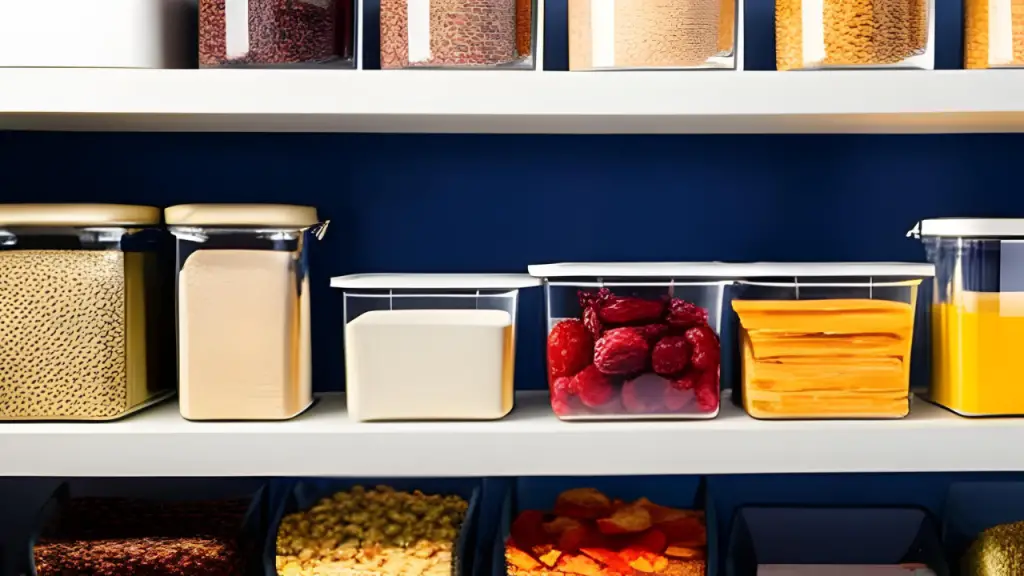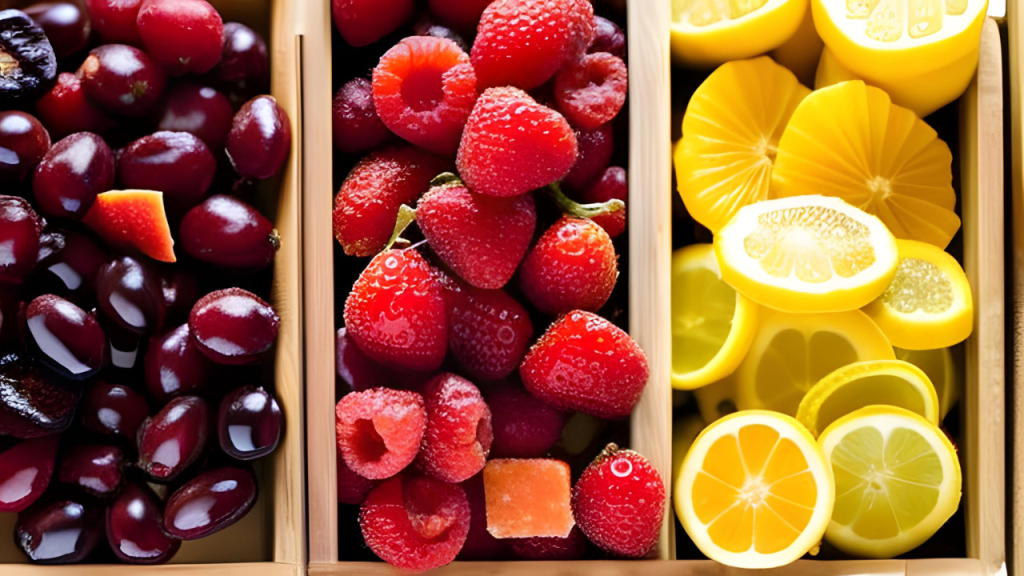When it comes to storing dried fruit in the pantry, proper techniques and practices are essential to maintain its freshness, flavor, and nutritional value. Dried fruits are a popular snack option for their long shelf life and convenience. Whether you enjoy dried apricots, raisins, or cranberries, understanding the best methods for storing them will ensure their quality is preserved over time. In this comprehensive guide, we will explore expert tips and tricks on how to store dried fruit in the pantry effectively.
How to Store Dried Fruit in the Pantry?
Dried fruits require specific conditions to remain fresh and flavorful. Here are some expert-recommended methods for storing dried fruit in the pantry:
Choose the Right Packaging
To maintain the quality of dried fruit, storing it in the appropriate packaging is crucial. Opt for airtight containers made of glass or plastic with a secure lid. Ensure the containers are clean and dry before use. Airtight packaging will prevent moisture and insects from reaching the dried fruit, thus preserving its flavor and texture.
Keep Away from Moisture
Moisture is the enemy of dried fruit. It can cause the fruit to become sticky, moldy, and lose its taste. Store dried fruit in a cool, dry place in your pantry, away from any source of moisture, such as sinks or windows. Moisture can also be present in the form of condensation, so ensure the storage area is free from excess humidity.

Avoid Exposure to Light
Light can cause dried fruit to lose its color and nutritional value. Keep dried fruit in opaque containers or store them in a dark corner of your pantry. This will protect the fruit from the harmful effects of light, ensuring it stays fresh and vibrant.
Maintain Consistent Temperature
Extreme temperatures can impact the quality of dried fruit. Fluctuations in temperature can lead to moisture absorption or loss, affecting the texture and taste of the fruit. Store dried fruit in an area of your pantry where the temperature remains consistent, ideally between 50°F and 70°F (10°C and 21°C).
Check for Signs of Spoilage
Regularly inspect your dried fruit for any signs of spoilage, such as mold, discoloration, or an off-putting odor. If you notice any such signs, discard the affected pieces immediately to prevent the spread of spoilage to the rest of the batch.
Guide to Dried Fruit and Dehydrated Food Storage
Why Proper Storage is Essential
Dried fruits and dehydrated foods are popular for their extended shelf life, nutritional value, and concentrated flavors. However, proper storage is paramount to ensure these benefits. Properly stored dried foods retain their nutrient content and resist mold growth, spoilage, and insect infestation.
In-Depth Look at Storage Containers
- Glass Containers: These are top-rated for dried fruit storage. They don’t harbor odors, and their transparency allows easy identification of the contents. The airtight seal of mason jars, in particular, ensures a moisture-free environment which is essential for the longevity of dried fruits.
- Plastic Containers: Opt for high-quality, BPA-free plastic containers. While they are lightweight and durable, ensure they seal tightly. Over time, some plastic can become permeable, allowing moisture and odors to penetrate.
- Vacuum-sealed Bags: These bags significantly reduce air exposure, preventing the oxidation process that can degrade dried fruits’ quality.
Factors Influencing Dried Fruit’s Freshness
- Moisture: The arch-enemy of dried foods. Even the slightest moisture can lead to mold growth.
- Air: Oxygen can cause oxidation, leading to loss of flavor and nutrients.
- Light: Direct sunlight or artificial light can degrade the quality and nutritional value.
- Temperature: Cool and consistent temperatures are ideal. Fluctuations can introduce moisture.
Storing at Floor Level: Best Practices
The floor can often be the coolest part of a room, but storing directly on the floor can introduce potential issues:
- Pests: Insects and rodents are more likely to access ground-level food items.
- Moisture: Direct contact with the floor, especially concrete, can transfer moisture to containers.
Using raised shelving or pallets prevents these issues and aids in air circulation, ensuring your dried foods remain dry.
Climate Considerations: The UK Scenario
The UK, with its often damp and fluctuating climate, presents unique challenges:
- Airtight Containers: These are non-negotiable. They prevent the humid air from making dried foods soggy.
- Desiccants: Consider adding silica gel packets to your containers. These will absorb any stray moisture, providing an extra layer of protection.
Refrigeration: A Boost to Shelf Life
While refrigerating dried fruits is not always necessary, doing so can be beneficial. The cold environment slows down any potential degradation processes, ensuring that your dried fruits remain as flavorful and nutritious as the day you stored them.
Dried fruits and dehydrated foods are a boon, especially for those who like to prep or enjoy flavorful snacks all year round. However, their longevity and quality are heavily reliant on storage methods. Understanding and implementing proper storage techniques ensures the best taste, texture, and nutritional value for your dried goods.
Dried Fruit Storage Containers: Best Choices for Freshness
Storing dried fruit in the right containers is crucial for maintaining its freshness and preventing spoilage. Glass containers with airtight lids, like mason jars, are often recommended because they are non-reactive, and the clear glass allows you to see the contents easily.
Plastic containers with tight-fitting lids are also suitable, but ensure they are BPA-free to avoid chemical contamination. Vacuum-sealed bags are another viable option, especially for long-term storage.
Storing Dried Fruit in Mason Jars: A Time-Tested Method
Mason jars, known for their durability and airtight sealing, are perfect for storing dried fruit. When using mason jars:
- Ensure the fruit is completely dry.
- Fill the jars, leaving a little space at the top.
- Seal them tightly to prevent air and moisture entry.
- Store in a cool, dark place away from direct sunlight.
How Long is Dried Fruit Good for After Opening?
Once opened, dried fruit’s shelf life depends on storage conditions. If stored properly in a cool, dark place, most dried fruits can last 3-6 months. However, always check for signs of mold or off odors. Using resealable bags or containers and refrigeration can extend the freshness.
How to Store Dehydrated Fruit Long Term: Key Steps for Preservation
For long-term storage of dehydrated fruit:
- Use oxygen absorbers to prevent oxidation.
- Consider vacuum-sealing to minimize air exposure.
- Store in a cool, dark, and dry place, ideally between 50°F and 60°F.
- Regularly check for any signs of spoilage or pests.
Dehydrated food, when stored correctly, can last for years. For optimum longevity:
- Use oxygen absorbers and vacuum-sealed containers.
- Store in a dark, cool, and dry environment.
- Mylar bags can provide an added layer of protection against light and pests.
- Regularly inspect your stash and rotate stocks to ensure freshness.
How Should Dried Food be Stored at Floor Level?
When storing dried food at floor level:
- Use raised shelving or pallets to keep the food off the direct floor and allow air circulation.
- Ensure the storage area is free from moisture or potential water seepage.
- Keep away from direct sunlight or heat sources.
How Should Dried Food be Stored in the UK?
In the UK, where humidity can fluctuate:
- Opt for airtight containers to prevent moisture ingress.
- Store away from radiators or ovens in a cool, dark pantry or cupboard.
- Silica gel packets can be added to containers to absorb excess moisture.

How Long Does Dried Fruit Last in the Fridge?
Refrigerating dried fruit can extend its shelf life. When refrigerated, most dried fruits can remain fresh for up to a year. However, always inspect them before consumption for any signs of spoilage.
How Long Can You Store Dried Fruit in the Pantry?
Dried fruit has an impressive shelf life when stored properly. Dried fruit can generally be stored in the pantry for six months to a year. However, this can vary depending on the type of dried fruit and the storage conditions. Some fruits, like raisins or dates, can last even longer if stored correctly. Always check the packaging or consult the specific fruit’s guidelines for more accurate information on storage duration.
FAQs about Storing Dried Fruit in the Pantry
Can you freeze-dried fruit for long-term storage?
Yes, freezing dried fruit is an excellent option for long-term storage. Place the dried fruit in a freezer-safe, airtight container or resealable bag. When properly frozen, dried fruit can last up to a year without significantly losing flavor or texture.
Should I wash dried fruit before storing it in the pantry?
No, washing dried fruit before storing it in the pantry is unnecessary. Washing can introduce moisture, which can lead to spoilage. Dried fruit goes through a dehydration process that removes moisture, making it safe for direct storage.
Can I store different types of dried fruit together?
It is best to store different types of dried fruit separately to prevent cross-contamination of flavors and odors. Some fruits, like apricots, may have a stronger aroma that can affect the taste of other fruits. Store each type of dried fruit in individual airtight containers or use separate compartments within a larger container.
Are there any special considerations for storing organic dried fruit?
Organic dried fruit should be stored using the same guidelines as a conventional dried fruit. However, organic fruit may have a slightly shorter shelf life since it does not contain preservatives. Checking the packaging or consulting the supplier for specific storage instructions is essential.
Can I store dried fruit in the refrigerator?
While storing dried fruit in the refrigerator is possible, it is not recommended. The refrigerator’s cool temperature and higher humidity levels can cause the fruit to become sticky and absorb odors from other foods. Storing dried fruit in the pantry is the preferred method for maintaining its quality.
What are the signs of spoiled dried fruit?
Spoiled dried fruit may exhibit signs such as mold growth, an unusual odor, or a significant change in color and texture. If you notice any of these signs, it is best to discard the dried fruit to avoid any potential health risks.
Conclusion
Knowing how to store dried fruit in the pantry is essential to preserve its flavor, texture, and nutritional value. By following the expert tips and tricks provided in this guide, you can ensure your dried fruit remains fresh and enjoyable for an extended period. Remember to choose appropriate packaging, keep the fruit away from moisture and light, maintain a consistent temperature, and regularly inspect for signs of spoilage. By implementing these storage practices, you can savor the deliciousness of dried fruit whenever you desire.

